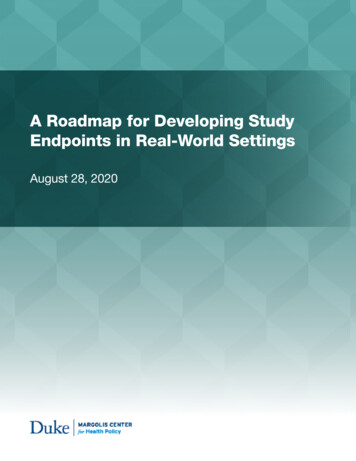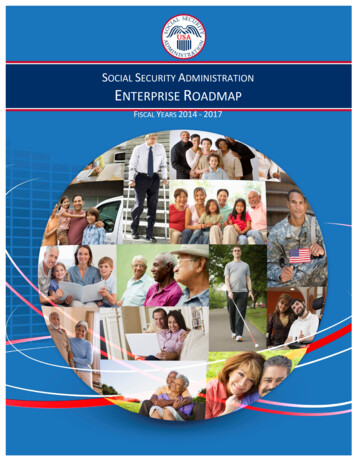
Transcription
A Roadmap for Developing StudyEndpoints in Real-World SettingsAugust 28, 2020
Table of ContentsBackground . 1What is an Endpoint? . 2Translating Lessons Learned to the Real-World Setting . 3Building a Real-World Endpoint . 4Concept of Interest . 4Outcome . 4Endpoint . 5Arriving at a Real-World Endpoint. 9Validating a Real-World Endpoint . 10Concept Validation. 10Tool Validation . 10Opportunities to Improve the Development of Real-World Endpoints. 13Conclusion . .15Appendix A. Workshop Participants . 16Appendix B. Glossary . 20Appendix C. Types of Endpoints . 23Appendix D. Regulatory Programs, Pathways, and Initiatives thatSupport Development of Real-World Endpoints . 25Appendix E. Iterative Process of Endpoint Development . 27Appendix F. Examples of Stakeholder Efforts that Support theDevelopment of Real-World Endpoints . 28References . 30i
About the Duke-Margolis Center for Health PolicyThe Robert J. Margolis, MD, Center for Health Policy at Duke University is directed by Mark McClellan, MD, PhD,and brings together expertise from the Washington, DC, policy community, Duke University, and Duke Health toaddress the most pressing issues in health policy. The mission of Duke-Margolis is to improve health and the valueof health care through practical, innovative, and evidence-based policy solutions. Duke-Margolis catalyzes DukeUniversity’s leading capabilities, including interdisciplinary academic research and capacity for education andengagement, to inform policy making and implementation for better health and health care.For more information, visit healthpolicy.duke.edu.AcknowledgmentsThe Duke-Margolis Center would like to thank several individuals for their contributions to this white paper. Thispaper’s development was guided by the collaboration of the working group members listed on page iv. We aregrateful for the working group’s extensive subject matter expertise and thoughtful feedback throughout thepaper’s development. We are also appreciative of the broader Real-World Evidence Collaborative Advisory Groupfor their guidance. We would like to thank those who participated in the Duke-Margolis private workshops,“Establishing Guideposts for Developing Real-World Endpoints” held September 16, 2019 and February 26, 2020 (alist of attendees can be found in Appendix A). In addition, we are grateful to Patricia Green from the Center for hercommunications guidance. We would like to thank Celeste Ferguson from Duke University for her support indeveloping graphics for this white paper. Finally, we acknowledge Rachael Lussos from Graham Associates for hereditorial assistance.Any opinions expressed in this paper are solely those of the authors and do not represent the views or policies ofany other organizations external to Duke-Margolis. Funding for this work is made possible through the generosityof the Margolis Family Foundation, which provides core resources for the Center, as well as a combination offinancial and in-kind contributions from Real-World Evidence Collaborative members, including AbbVie; Amgen; EliLilly and Company; Pfizer; Genentech, a member of the Roche Group; GlaxoSmithKline; Merck; Novartis; Teva; andUCB. For more information on the Real-World Evidence Collaborative, orld-evidence-collaborative.DisclosuresMark B. McClellan, MD, PhD, is an independent board member on the boards of Alignment Healthcare, Cigna,Johnson & Johnson, and Seer; co-chairs the Guiding Committee for the Health Care Payment Learning and ActionNetwork; and receives fees for serving as an advisor for Arsenal, Blackstone Life Sciences, and MITRE.ii
WHITE PAPERA Roadmap for Developing StudyEndpoints in Real-World SettingsDUKE-MARGOLIS AUTHORSKerra MerconKathryn LallingerNirosha MahendraratnamAdam KroetschJoy EckertHuzyfa FaziliChristina SilcoxMarta WosińskaMorgan RomineMark McClellaniii
WORKING GROUPJeff AllenFriends of Cancer ResearchLinda KalilaniUCBBryce ReeveDuke UniversityAylin AltanOptumLabsLee KallenbachVeradigm HealthMatthew ReynoldsIQVIAShrujal BaxiFlatiron HealthEric KleinEli Lilly and CompanyFrank RockholdDuke UniversityMarc BergerISPORLaura KoontzFlatiron HealthJason SimeoneEvideraAndrew BevanEvideraErem LatifEvideraAriel BourlaFlatiron HealthGrazyna LiebermanGenentechRachel SobelISPEUnited BiosourceCorporationSusan ColillaTeva PharmaceuticalsRenato LopesDuke UniversityGracy CraneF. Hoffmann- La RocheNicole MahoneyFlatiron HealthCynthia de LuisePfizerAnnie McNeillAbbVieShannon FerranteGlaxoSmithKlineLinda NelsenGlaxoSmithKlineLuca FoschiniEvidation HealthJosephine NorquistMerck & Co.Marni HallIQVIAElisabeth OehrleinNational Health CouncilRohini HernandezAmgenSally OkunUnitedHealth Group R&DStacy HoldsworthEli Lilly and CompanyKristen JohnsonNovartisLucinda OrsiniISPORMark StewartFriends of Cancer ResearchDavid ThompsonSyneos HealthEileen Mack ThorleyPatientsLikeMeAracelis TorresFlatiron HealthEmese TothUCBStuart TurnerNovartisMelissa Van DykeGlaxoSmithKlineVince WilleyHealthCoreWei ZhouMerck & Co.iv
ADVISORY GROUPAylin AltanOptumLabsSolomon IyasuMerck & Co.Eleanor PerfettoNational Health CouncilMarc BergerISPORRyan KilpatrickAbbVieRichard PlattHarvard Medical SchoolBarbara BiererThe Multi-Regional ClinicalTrials Center of Brigham andWomen's Hospital andHarvardLisa LaVangeUNC Gillings School of GlobalPublic HealthStephanie ReisingerVeradigm HealthCathy CritchlowAmgenWilliam CrownThe Heller School for SocialPolicy and Management atBrandeis UniversityRiad DiraniTeva PharmaceuticalsJacqueline LawGenentechChristina MackISPE RepresentativeIQVIASally OkunUnitedHealth Group R&DEileen Mack ThorleyPatientsLikeMeNancy DreyerIQVIANicole MahoneyFlatiron HealthAndrew EmmetPfizerBrian MayhewNovartisCarlos GarnerEli Lilly and CompanyDavid MillerUCBJohn GrahamGlaxoSmithKlineBray Patrick-LakeEvidation HealthDebra SchaumbergEvideraDavid ThompsonSyneos HealthRichard WillkeISPORMarcus WilsonHealthCoreObserverAmanda Wagner-GeeNational Academies ofSciences,Engineering, and Medicinev
EXECUTIVE SUMMARYWith growing interest in using real-world data (RWD) and real-world evidence (RWE) to supportregulatory decision-making, stakeholders are considering how to develop robust real-world studyendpoints to evaluate medical product effectiveness when fit-for-use data and valid methods areavailable. Despite extensive literature and guidance for developing clinical trial endpoints, few resourcessupport real-world endpoint development. Some principles can be carried over from the clinical trialsetting, but differences in patient populations, care settings, and data collection in the real-world settingresult in unique considerations for endpoint development. Additionally, studies conducted in the realworld setting have the potential to capture outcomes that are more relevant to patients than outcomescaptured in clinical trials.This paper explores how key differences in studysettings influence a researcher’s considerationsfor developing study endpoints in the real world.First, because stakeholders involved in the realworld endpoint development process havemultidisciplinary backgrounds, this paper detailsthe current landscape of endpoint development,provides standardized definitions of keyconcepts, and introduces existing frameworks.Second, this paper presents a roadmap forendpoint development, beginning with selectionof a concept of interest and study outcome thatreflect the research question. Within thisroadmap, the paper details how real-worldsettings impact selection of a concept of interest,outcome, and endpoint components, raisingchallenges for researchers to consider whendeveloping real-world endpoints. Third, thispaper addresses key considerations for thevalidation of real-world endpoints. Finally, thispaper examines opportunities to enhance theuse of real-world endpoints through stakeholdercollaboration.How This Paper Was DevelopedThis paper is informed by a literature review, twoprivate workshops on “Establishing Guideposts forDeveloping Real-World Endpoints” (September 16,2019 and February 26, 2020), and the expert opinionof the Duke-Margolis RWE Collaborative RWEndpointsWorking Group. During the workshops, stakeholderexperts representing sponsors, academic researchgroups, data vendors, providers, and patient networksdiscussed the current and evolving landscape aroundendpoint development in the real-world setting. Thiswork builds on Duke-Margolis’s recommendationspublished in: 1) Adding Real-World Evidence to aTotality of Evidence Approach for Evaluating MarketedProduct Effectiveness (2019), 2) Need for NonInterventional Studies Using Secondary Data toGenerate Real-World Evidence for Regulatory DecisionMaking, and Demonstrating Their Credibility (2019), 3)Determining Real-World Data’s Fitness for Use and theRole of Reliability (2019), 4) Characterizing RWDQuality and Relevancy for Regulatory Purposes (2018),and 5) A Framework for Regulatory Use of Real-WorldEvidence (2017).vi
BackgroundStakeholders are eager to increase the use ofreal-world data (RWD)—“data relating to patienthealth status and/or the delivery of health careroutinely collected from a variety of sources”—throughout the life-cycle of drug development,approval, and access.1* In particular, stakeholderswant to analyze RWD to generate real-worldevidence (RWE) about the use, benefits, and risksof medical products and then make that RWEactionable by health care decision makers.1 FDAis exploring the use of RWD and RWE forregulatory decision-making, per Congressionalmandates in the 21st Century Cures Act and 6thPrescription Drug User Fee Act (PDUFA). TheDecember 2018 Framework for FDA’s Real-WorldEvidence Program is an important step in thisexploratory process.1The Value of Real-World Data and RealWorld EvidenceRWE studies can complement evidence fromrandomized controlled trials (RCTs) and contribute toa robust evidence package to support regulatorydecision-making. There is a well-established history ofthe FDA using RWE to support labeling changesrelated to safety; however, RWE studies might also beuseful in labeling changes related to effectiveness.RWD is often collected by providers as part of clinicalpractice throughout the health system. Therefore,RWD can support analyses that better represent thebroader impact of a medical product, including routineclinical care and self-care. RWD can also continuouslycapture the evolving standard of care, whereas RCTscapture information during a specified timeline.Drawing from RWD, RWE studies often have broaderinclusion criteria than traditional RCTs, which mightprovide insight into the impact of a drug on patientswho were not represented in the RCT. RWE studiesmight also capture outcomes that are more relevantto prescribers and patients. RWE might be generatedmore efficiently and with fewer resources, increasingthe availability of information that might nototherwise be generated.Integral to improving the acceptability of realworld studies by regulatory decision-makers isstudy quality, including data fitness for use andthe ability of the methods to support valid causalinference, as well as the regulatory and clinicalcontexts.2-6 One key step toward generatingregulatory-grade RWE is developing robust andrelevant endpoints that can address a researchquestion about a medical product’s safety or effectiveness in the real-world setting: real-worldendpoints.*A glossary of relevant terms can be found in Appendix B.1
What is an Endpoint?As defined in the FDA-NIH Biomarker Working Group’s Biomarkers, EndpointS, and other Tools (BEST)glossary, an endpoint is “a precisely defined variable intended to reflect an outcome of interest that isstatistically analyzed to address a particular research question.”7 Endpoints are characterized by thetype of research question they aim to answer, the outcomes they capture, and how they are used in thestudy design (Table 1). Effectiveness endpoints answer research questions that intend to demonstratethat an intervention or exposure results in a clinical benefit, defined as “a positive effect on how anindividual feels, functions, or survives.”7 Endpoint types are characterized by the manner in which theoutcome (or outcomes) are captured. Endpoints are also grouped within the statistical hierarchy,† asdefined by the study design.8 Endpoints can also be classified according to whether they are novelcompared to commonly accepted endpoints. (For more information on the types of endpoints, includinga discussion on endpoint novelty, see Appendix C).Table 1. Endpoint types are categorized by how outcomes are captured and by their position in thestatistical hierarchy.Researchers balance the tradeoffs of an ideal real-world endpoint with practical considerations, such asthe feasibility and relevancy of the endpoint. For example, a composite endpoint may best answer aresearch question, but if capturing multiple outcomes in the RWD source is not feasible or presents asignificant burden for providers, a different endpoint might be considered.Characterizing the endpoint by the outcomes it captures and the endpoint’s position in the statisticalhierarchy is necessary for determining the appropriate statistical analyses. Positioning in the statisticalhierarchy can also impact the regulatory acceptability of the endpoint. For example, secondary andexploratory endpoints might be less likely to inform a product’s label.†The statistical hierarchy refers to a grouping of endpoints by clinical importance, expected frequency of the event, and anticipateddrug effects.2
Translating Lessons Learned to the Real-World SettingDeveloping real-world endpoints is challenging due to the lack of adequate literature, standardized bestpractices, and regulatory guidance that address the differences in endpoint development between theclinical trial and real-world settings. Differences in data collection practices, patient populations, andcare patterns in the real-world setting might require certain endpoint components that a clinical trial forthe same disease or condition might not use. The uncertainty introduced by these differences may alsorequire analytical and study design approaches distinct from the approaches used in clinical trials.Although literature on developing real-world endpoints is limited, many lessons can be learned fromclinical trial endpoint development, which has been detailed extensively for decades across peerreviewed publications, multi-stakeholder standards-setting bodies, and international collaborativeefforts. FDA itself has outlined many key considerations for clinical trial endpoint development in atleast four cornerstone guidance documents: Clinical Trial Endpoints for the Approval of Cancer Drugs and BiologicsMultiple Endpoints in Clinical TrialsExpedited Programs for Serious Conditions – Drugs and BiologicsPatient-Reported Outcome Measures: Use in Medical Product Development to Support LabelingClaimsFDA does not state a preference for type of endpoint chosen to demonstrate effectiveness. However,the Demonstrating Substantial Evidence of Effectiveness for Human Drug and Biological Productsguidance notes that “the most straightforward and readily interpreted endpoints are those that directlymeasure clinical benefit or are validated surrogate endpoints shown to predict clinical benefit.”9Throughout its endpoint guidances, FDA also references the estimand framework: a structuredframework on developing a regulatory-grade research question to determine if an intervention orexposure results in a clinical benefit.‡10,11 FDA provides feedback on endpoint development through avariety of mechanisms summarized in Appendix D.Endpoint development is framed by the clinical and regulatory contexts surrounding the researchquestion. Clinical context includes the understanding of the disease, treatment alternatives, therapy,patient perspective, and provider perspective.6,12 Important regulatory context factors include theintended purpose of the endpoint (including labeling), the available regulatory review and approvalpathways, and the relevant information and evidence from any previous regulatory decisions for thegiven disease or condition. For example, endpoints used previously to support a regulatory approvalmay have greater acceptability to support labeling changes for other medical products. It is important tonote that regulatory acceptability is based on the evaluation of clinical studies through the totality ofevidence approach, where the evidence base to support effectiveness is consistently growing andevolving and real-world studies are often not evaluated in isolation.6‡Theestimand framework is detailed in ICH E9(R1) Addendum on Estimands and Sensitivity Analysis in Clinical Trials HarmonisedGuideline. More on how the estimand framework relates to endpoint development, including a case study, can be found in theDiscussion Document for Patient-Focused Drug Development Public Workshop on Guidance 4: Incorporating Clinical OutcomeAssessments into Endpoints for Regulatory Decision Making (PFDD Discussion Document 4).3
Building a Real-World EndpointFigure 1 depicts a new roadmap fordeveloping a real-world endpoint. Thisroadmap is to be applied to researchquestions studied using real-world data inconjunction with tools such as the estimandframework or target trial approach.10,13The real-world endpoint may be similar to thecommonly accepted endpoint used to supportclinical trials for the same disease orcondition. However, even “standardized”clinical trial endpoints often differ in definitionacross trials. For example, major adversecardiovascular events (MACE) is a commonlyused composite endpoint to assess cardiacoutcomes; however, definitions of MACEdiffer across clinical trials.14 Therefore, clearlydefining the endpoint through the selection ofthe concept of interest, outcome, andendpoint components is vital for any clinicaltrial or real-world study.Concept of InterestThe concept of interest (COI) is the “aspect of an individual’s clinical, biological, physical, or functionalstate, or experience that the outcome assessment is intended to capture or reflect.”7 For each diseaseor condition, a variety of COIs (e.g., functional status, mental health) are applicable.15,16 The COI dependson the research question and the clinical benefit of interest. The COI can also be informed by patientinput, the natural history of the disease, the aspect of the disease modified through a study, or thetargeted labeling.17The COI is likely consistent regardless of study setting. However, if a different COI is easier or moreavailable to measure in the real-world setting (e.g., clinical vs. physical) or more clinically relevant, thatCOI may be used instead. Choice of COI may also depend on the purpose of the study: to informregulatory decision-making, payer decision-making, or the standard of care in clinical practice.OutcomeAfter the COI is chosen, an outcome can be selected. An outcome is a “measurable characteristic that isinfluenced or affected by an individuals’ baseline state or an intervention as in a clinical trial or otherexposure.”7 Most clinical studies that support regulatory decision-making examine clinical outcomes(e.g., change in blood pressure, occurrence of stroke) or humanistic outcomes (e.g., leg mobility, healthrelated quality of life). In contrast, economic outcomes (e.g., cost per hospital stay day, incremental costeffectiveness ratio) related to medical products may support payer and health system decisionmaking.184
In many cases, the outcome measured in a study is the same regardless of setting because the outcomechosen for the clinical trial was carefully selected based on the disease definition and the impact oftreatment on the disease. However, the outcome may change if the measurement of treatment benefitis not captured in the real world in the same way as clinical trials. For example, cancer progression ismeasured using RECIST for clinical trials, but may be monitored by radiographic images or tumormarkers in the real world. Furthermore, researchers may consider whether there are outcomes moreroutinely captured in RWD that might better reflect the COI and whether the outcome is associated withan event is likely to be medically attended.EndpointAn endpoint is developed to measure the outcome. An endpoint is made of four components:1)2)3)4)Type of assessment madeAssessment tool usedTiming of the assessmentOther relevant details.7Each component is selected to reflect the COI and address the research question. The sequence in whicheach component is selected, and subsequent iteration, depends on the clinical and regulatory contexts.The following sections define each of the four components and discuss specific considerations forchoosing each component in the real-world setting.1Type of AssessmentThe type of assessment refers to the three typesof outcome assessments to evaluate clinicalbenefit: survival, clinical outcome assessments(COAs), and biomarkers. Survival often has a“well-defined means for determination.”19Generally, COAs measure symptoms, andbiomarkers measure a patient’s physiologicalstate.Types of Outcome Assessments1.2.Survival: Duration of survival.Clinical outcome assessments (COAs):Measurements of how patients feel andfunction, influenced by the judgement of aperson (respondent).7,19 The four types ofCOAs are clinician-reported outcomes(ClinROs), patient-reported outcomes (PROs),observer-reported outcomes (ObsROs), andperformance outcomes (PerfOs).7Biomarkers: Measurements of “normalbiologic processes, pathogenic processes, orresponses to an exposure or intervention”that serve as an objective, indirect patientassessment (e.g., protein levels in a bloodsample).7,19 Biomarkers are often used insurrogate endpoints.If the research question is the same for both theclinical trial and real-world settings, the type ofassessment may be the same. The type of3.assessment may change if there is a better wayof measuring the clinical benefit in the realworld setting (e.g., using an electronic PRO[ePRO] rather than a ClinRO to capture patientexperience). Availability of the assessment toolin the real world may also impact the decision(e.g., a PerfO [e.g., spirometry] may be used toevaluate COPD exacerbations in a clinical trial, but symptoms captured through ePROs may be used inthe real world).5
2Assessment ToolThe assessment tool is chosen to measure the outcome assessment. Traditionally, tools to measureCOAs have included paper or phone questionnaires, while biomarkers have been measured throughmolecular, histologic, radiographic, and physiologic tools.7 Many tools used in clinical trials may not bepractical, cost-effective, or relevant for use in the real-world setting. For example, frequent use of MRIsto measure an outcome is likely not possible as part of routine clinical care. Although some tools may beused in both clinical trial and real-world settings, real-world tools should be chosen in accordance withrelevance to patient care, regardless of whether the real-world tool is closely related to the commonlyaccepted tool. Secondary use data algorithms and digital measurement tools are two types of toolsoften used in real-world studies.Secondary Use Data AlgorithmsIn the real-world setting, tools to measure outcomes may rely on primary data capture, as is typical forclinical trials, or secondary use data. Common secondary use data sources include electronic healthrecords (EHRs), insurance claims, patient-generated health data, laboratory values, or genetic,biometric, or diagnostic reports. For secondary use data, an outcome might not be routinely collected orreported to the data source. Whether the outcome (or any variable) is captured in the dataset dependson whether the primary purpose of that data source has a systemic reason to report the outcome. Forclaims data, a code associated with the outcome is required for billing, whereas an EHR relies on clinicalobservation and reporting of an outcome. If the outcome is not included within a dataset, a researchermay be able to extract key variables from raw data (when available and accessible) or link the researchdataset with another data source with the relevant outcome information. Alternatively, researchers canuse an algorithm to extract the outcome, extract a variable selected as a “proxy” for the outcome, orderive the outcome based on available data from one or more sources.Developing an algorithm to address a research question is a multistage process. First, the researchermust determine if a commonly accepted standard for assessment of the outcome exists. If no commonlyaccepted standard exists or the standard is not accessible, the researcher must determine whether aclinically objective measurement exists. Some outcomes, such as lupus flares, do not have commonlyaccepted standards for assessment or clinically objective measurements. Developing an algorithm toassess lupus flares is therefore more difficult than for diseases or conditions with clinically objectivemeasurements (e.g., blood pressure as a biomarker for hypertension).20,21Because many sources of RWD are not collected specifically for research use, researchers must addressthe reliability of the data, including how to interpret data gaps. In most cases, the data is not truly“missing” but rather has not been documented. For example, data may not be present in an EHRbecause the clinician did not feel the test was necessary, the test was not accessible, or the results ofthe test were not recorded in the EHR. Another limitation of developing an algorithm for EHR data isthat the data usually reflects interactions with a particular clinician or health care system and is notrepresentative of the patient’s entire health care experience. In claims data, challenges exist with thecoding systems. Because multiple coding systems (e.g. ICD, WHO) have multiple versions, researchersmust understand which coding system was used when the algorithm was developed. Researchers alsomust account for miscoding in claims data.22 Additionally, the recorded diagnosis may be uncertain. Forinpatient settings, ICD-10 guidelines state that “If the diagnosis documented at the time of discharge isqualified as ‘probable,’ ‘suspected,’ ‘likely,’ ‘questionable,’ ‘possible,’ or ‘still to be ruled out,’‘compatible with,’ ‘consistent with,’ or other similar terms indicating uncertainty, code the condition as6
if it existed or was established.”23 This practice may make it difficult for researchers to determine if thediagnosis was the true diagnosis or a probable diagnosis.Multiple RWD sources may be used for algorithm development, and these sources may be discordant.As such, an algorithm derived from claims data will likely differ from an algorithm derived from EHRdata. Depending on the sources of the data, some endpoint types may be more feasible to use thanothers. For example, composite and multi-component endpoints may be difficult to obtain in claims dataif a patient’s comorbidities are not consistently coded upon hospital and clinician office visits.Digital Measurement ToolsDigital measurement tools are increasingly used to measure COAs or biomarkers in both clinical trialsand real-world studies.24§ Digital measurement tools refer to both devices used in clinical care andpatient-generated health data collected through mobile health technologies and consumer devices.25Digital measurement tools may be electronic versions of traditional tools (e.g., paper questionnaires) ortools that measure an outcome in a different way than the traditional tool.24 For example, ePROs can becaptured through digital questionnaires, potentially administered through apps or texts sent to patients,or captured in the EHR. Digital questionnaires can also be used to capture ClinROs or ObsROs. PerfOs aretypically measured digitally through active sensors as a patient knowingly performs a task.25Digital biomarkers (i.e., “objective, quantifiable, physiological, and behavioral measures that arecollected by means of digital devices that are portable, wearable, implantable, or digestible”) may becollected though active or passive sensor data.24,26 For example, a continuous glucose monitor is
The Robert J. Margolis, MD, Center for Health Policy at Duke University is directed by Mark McClellan, MD, PhD, and brings together expertise from the Washington, DC, policy community, Duke University, and Duke Health to address the most pressing issues in health policy. The mission of Duke-Margolis is to improve health and the value











